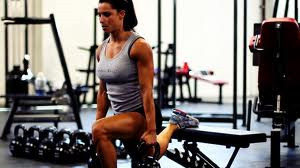Do you have any muscle imbalances? Yeah, me too, and so does almost everyone else currently reading this article. What gives? Well some of us tend to favor one side over the other in our day to day activities. Some of us have had previous injuries that forced us to rely on one side of our body for a prolonged period of time. And some of us only use one hand to….well, I think you can figure that one out. Whatever the case may be, muscle imbalances aren’t cool, they hinder your performance and increase your risk of injury, and we need to do something about them. There are multiple ways to resolve muscle imbalances, but my favorite, and what I consider to be the most effective way to go about this endeavor, is to start incorporating unilateral (single limb) exercises in to your training.
Both Limbs Move Equal Loads
The reason unilateral exercises are so great at improving muscle imbalances are because both sides of the body are forced to move equal loads. When we do bilateral (double limb) movements, we tend to subconsciously allow our dominant side to pick up slack for the weaker one. With dumbells, the weights aren’t linked, so either the weaker limb gets the weight up, or it doesn’t.
Now obviously I don’t think that single arm/leg exercises should be emphasized over bilateral (double limb) exercises. Barbells can be loaded with much more weight than dumbells, and progressive overload is the number one way to increase overall strength and hypertrophy (muscle growth). However, it’s important to have the ability to use both sides of the body equally, and throwing in unilateral exercises as accessory work will go leaps and bounds in helping you achieve this goal.
My Favorite Unilateral Exercises
Some of my favorite unilateral exercises are as follows:
- Lower Body
- Bulgarian Split Squats
- Lunges (all variations)
- Single Leg Romanian Deadlift
- Single Leg Glute Bridge
- Single Leg Press
- Upper Body
- Single Arm Chest Press (all variations)
- Single Arm Dumbell Shoulder Press (all variations)
- Dumbell Rows
*I want to note that a few other great unilateral lower body exercises are the pistol squat, single leg glute ham raise, and single leg deadlift. I didn’t include them in MY list of favorites because well, I can’t/don’t do them.
All of the exercises listed above are great accessory movements to complement your main lift of each session. This obviously isn’t anywhere close to the total number of unilateral exercises and variations out there, but they are all compound lifts that closely resemble their bilateral counterparts, and are the ones I feel give you the most bang for your buck.
Programming
There isn’t necessarily a right way to program unilateral exercises into your training, but here are a few guidelines to follow:
- Unilateral exercise should come AFTER the main lift of the day
- Choose one or two exercises per session
- 3-4 sets per exercise
- 6-20 reps per set
- START WITH THE WEAKER LIMB
Remember that unilateral exercises are accessory work, and not the main focus of your training sessions. The volume and intensity of these exercises should be high enough to elicit a training response, but not so high that they take away from your recovery on the main lifts.
Now I know that 6-20 reps is a broad range when deciding the number of reps you want to do per set, but that’s because different rep ranges train different physical qualities. Anything over 15 reps will train endurance and hypertrophy (muscle growth), 8-15 reps will train hypertrophy, and 6-7 reps will train strength/hypertrophy. 1-5 reps will elicit gains in maximal strength, but I think the harm far outweighs the benefits of using near maximal loads with single arm/leg work, so save the max strength work for bilateral movements.
On a final note, always use the WEAKER SIDE FIRST. Remember, we are trying to fix an imbalance. Starting with the strong side will generally result in you getting more reps with a given weight on that side than you will be able to with your weaker side, further enhancing the problem. Start with the weaker side first, and whatever the number of reps you get with that side, stop there with the dominant side, even if you could do more. Over time, the weaker side will catch up and everything will balance out.
Summing Up
I remember looking myself in the mirror a few months back and going, “WHAT THE F***!? My left bicep was smaller than my right bicep (I looked like one of those world class arm wrestlers), my right tricep was smaller than my left tricep, my left quad was bigger than my right quad, my right hamstring was bigger than my left hamstring, and left pec was bigger than my right pec. Lets just say I had a lot of imbalances going on.
I have tried a lot of things to get my body a bit more symmetrical, and none of them have yielded as good of results as incorporating unilateral exercises in to my training. Single limb exercises not only help balance out your muscular strength and hypertrophy from side to side, but they illuminate and resolve any stability and mobility issues that are hindering proper movement and optimal performance.
If you have no imbalances (like hell you don’t), you should still throw unilateral exercise in to your training. Their benefits go far beyond what was discussed in this article. If you do have a noticeable difference from side to side, start performing unilateral exercises on a consistent basis, and you will be amazed at the changes you make over the next few months.
 Contact Nick:
Email- nsmoot2@gmail.com
Twitter- SmootFit
Facebook- Smoot Fitness
Contact Nick:
Email- nsmoot2@gmail.com
Twitter- SmootFit
Facebook- Smoot Fitness
Like What You See?
Get the Smoot Fitness Guide to Getting Stronger - FREE.


Leave a Reply